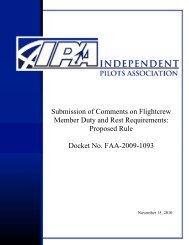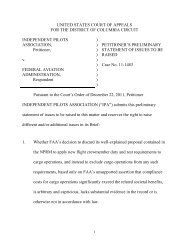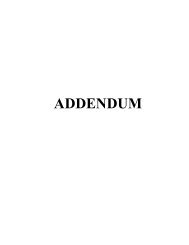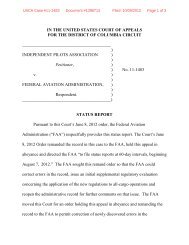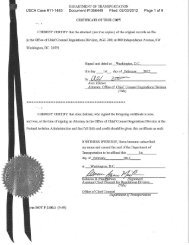Exhibits Vol 2 - Independent Pilots Association
Exhibits Vol 2 - Independent Pilots Association
Exhibits Vol 2 - Independent Pilots Association
Create successful ePaper yourself
Turn your PDF publications into a flip-book with our unique Google optimized e-Paper software.
FATIGUE MODEL VALIDATION<br />
69<br />
(measured in arbitrary units) as those representing up to 100%<br />
of the maximum produced for a standard work week (0-40<br />
units). Moderate fatigue scores represent a range between 40-<br />
80 units (100 to 200% of the maximum produced for a<br />
standard work week) and high fatigue scores (greater than 80<br />
units) are 200% or more of the maximum produced for a<br />
standard work week. In the same way that the effects of<br />
fatigue on performance likely have a non-linear relationship, it<br />
is assumed that fatigue scores do not progress in a linear<br />
fashion. For example, a score of 80 most likely does not<br />
represent double the fatigue level experienced at a score of 40.<br />
Model Validations<br />
Our previous validations of the work-related fatigue model<br />
suggest that the outputs accurately reflect changes in measures<br />
such as objective performance, vigilance, objective and<br />
subjective sleepiness, and tiredness (Dawson and Fletcher,<br />
2001; Fletcher and Dawson, 2001). However, a useful<br />
extension of such an approach is being able to equate the<br />
relative impairment observed in such measures with<br />
impairment due to specific levels of fatigue. Furthermore, it<br />
would also be useful to compare the relative impairment due to<br />
fatigue with impairment from other sources such as alcohol<br />
intoxication. Therefore, the aim of the present study was to<br />
assess and further validate the work-related fatigue model<br />
against performance impairment produced by sleep deprivation<br />
and alcohol intoxication in laboratory trials. In addition, this<br />
will allow predictions of performance impairment (due to the<br />
influences of either sleep deprivation or alcohol intoxication) to<br />
be made from calculated work-related fatigue scores.<br />
METHODS<br />
Subjects<br />
Data for twenty-two healthy university students with a<br />
mean age of 22.0 years (SEM±0.58) were included in this<br />
study. The performance data for these subjects were included<br />
in a previous study comparing the performance impairment<br />
of sleep deprivation and alcohol intoxication (Lamond and<br />
Dawson, 1999). Subjects were screened for good general<br />
health and good sleep status prior to the study. Only social<br />
drinkers were included; abstinence or excessive drinking was<br />
grounds for exclusion. Subjects with a history of sleep<br />
and/or psychiatric disorders or that were taking medications<br />
known to interact with alcohol or affect neurobehavioral<br />
performance or sleep were excluded from participation.<br />
Procedure<br />
<strong>Vol</strong>unteers participated in an alcohol intoxication condition,<br />
placebo condition, and sleep deprivation condition, performed<br />
in a counterbalanced fashion with at least one week between<br />
conditions. Subjects were required to arrive at the laboratory<br />
at 2000 h on the night prior to each condition and they slept<br />
overnight in separate rooms in The Queen Elizabeth Hospital<br />
sleep research laboratory.<br />
Four neurobehavioral performance tests were performed<br />
using a battery developed by Worksafe Australia. Detailed<br />
information on the specific battery of tests is given in Lamond<br />
and Dawson (1999), however they are discussed briefly<br />
hereafter. The tasks used in this study were a grammatical<br />
reasoning task (GRT) consisting of 32 presentations over 2-3<br />
minutes, an unpredictable tracking task (TRK) of 3-minutes<br />
duration, a vigilance task (VIG) of 3.5-minutes duration, and a<br />
simple sensory comparison task (SSC) consisting of 24 stimuli<br />
presented over 1-2 minutes. Subjects were thoroughly trained<br />
on the tasks prior to commencement of each experimental<br />
condition, and all tasks were presented in counterbalanced<br />
order each time the battery was completed.<br />
In each condition, subjects were woken at 0700 h and hourly<br />
performance testing on all four tasks was measured from 0800<br />
h. The results of the 0800 h tests were used as a baseline<br />
reference with which all subsequent test data were compared.<br />
In the sleep deprivation condition, subjects remained awake<br />
until performance testing was completed at 1400 h on the<br />
following day. In the alcohol intoxication condition, subjects<br />
consumed an alcoholic beverage at 30-minute intervals from<br />
0900 h until their Blood Alcohol Concentration (BAC) reached<br />
approximately 0.10%. Both alcohol intoxication and placebo<br />
condition performance testing were completed by<br />
approximately 1600 h.<br />
Work-related Fatigue Model<br />
To allow comparison with the performance impairments<br />
produced by alcohol intoxication and sleep deprivation, for<br />
each hour of the experiment we also modeled work-related<br />
fatigue to predict relative performance changes. The generated<br />
hourly fatigue scores were then used in the following analyses<br />
as predictors of performance.<br />
Analyses<br />
Performance test scores were expressed relative to the<br />
average baseline (0800 h) scores obtained before each<br />
condition. The relative scores within each interval were then<br />
averaged across all subjects to determine the mean relative<br />
performance change. The analyses used hourly intervals<br />
and/or BAC intervals of 0.01%.<br />
Both simple linear and polynomial regressions, each<br />
modeled with an intercept through zero, were then performed<br />
for all six recorded performance measures: GRT response<br />
latency, GRT error rate, TRK score, VIG response latency,<br />
VIG % correct, and SSC % correct. Without exception,<br />
second-order polynomial regressions returned higher<br />
correlation coefficients for all variables and thus accounted for<br />
more of the variance in the data. Therefore, polynomial<br />
regression data were used in the remaining analyses.<br />
Regression equations were determined for each of these<br />
measures with both fatigue scores (FAT) and blood alcohol<br />
concentration (BAC) as the dependent measure and are<br />
reported in the results.<br />
In order that fatigue scores could be predicted using task<br />
scores and BAC, the fatigue score and blood alcohol<br />
concentration regression equations for each of the six<br />
measures needed to be solved simultaneously. This was<br />
also done so that equivalent impairment due to alcohol<br />
intoxication could be predicted using task scores and<br />
fatigue predictions.



